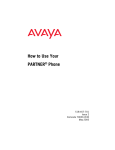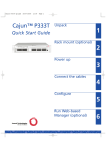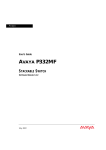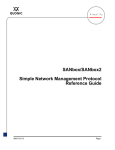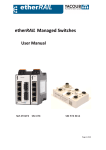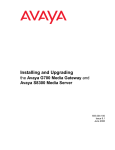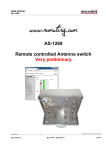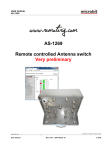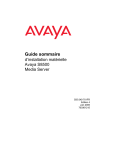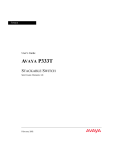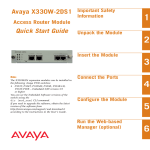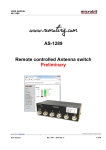Download Avaya C360 Quick Start Guide - Pdfstream.manualsonline.com
Transcript
Quick Start for Hardware Installation Avaya P333T-PWR Stackable Switch 10-300732 Issue 1 September 2005 Contents Chapter 1: Before you Start . . . . . . . . . . . . . . . . . . . . . . . . . . . . . . . 5 Gathering Information . . . . . . . . . . . . . . . . . . . . . . . . . . . . . . . . . Defining the Installation . . . . . . . . . . . . . . . . . . . . . . . . . . . . . . Preparing Contacts you might need . . . . . . . . . . . . . . . . . . . . . . . 5 5 5 Preparing Installation Files . . . . . . . . . . . . . . . . . . . . . . . . . . . . . . 6 Preparing Needed Tools . . . . . . . . . . . . . . . . . . . . . . . . . . . . . . . . 6 Choosing the Installation Site . . . . . . . . . . . . . . . . . . . . . . . . . . . . 6 Building a stack . . . . . . . . . . . . . . . . . . . . . . . . . . . . . . . . . . . . 8 Stack Master election rules . . . . . . . . . . . . . . . . . . . . . . . . . . . . . . 10 Chapter 2: Unpack the Device . . . . . . . . . . . . . . . . . . . . . . . . . . . . . . 13 Equipment . . . . . . . . . . . . . . . . . . . . . . . . . . . . . . . . . . . . . . . 13 Documentation. . . . . . . . . . . . . . . . . . . . . . . . . . . . . . . . . . . . . Avaya P330 Documentation and Utilities CD . . . . . . . . . . . . . . . . . . 14 15 Chapter 3: Mount the Device . . . . . . . . . . . . . . . . . . . . . . . . . . . . . . . 17 Before you Install the P333T-PWR in a Rack. . . . . . . . . . . . . . . . . 17 Chapter 4: Power Up . . . . . . . . . . . . . . . . . . . . . . . . . . . . . . . . . . . 19 AC input . . . . . . . . . . . . . . . . . . . . . . . . . . . . . . . . . . . . . . . . 19 DC input (optional). . . . . . . . . . . . . . . . . . . . . . . . . . . . . . . . . . . 20 Chapter 5: Prepare for Configuration . . . . . . . . . . . . . . . . . . . . . . . . . . 21 Establishing a Console Connection . . . . . . . . . . . . . . . . . . . . . . . . . 21 Assigning a Stack IP Address . . . . . . . . . . . . . . . . . . . . . . . . . . . . 22 Establishing a Telnet Connection. . . . . . . . . . . . . . . . . . . . . . . . . . . 23 Configuring the Switch . . . . . . . Basic configuration . . . . . . . Assigning the Stack IP Address Avaya P333R Default Settings . . . . . 23 24 24 24 Chapter 6: Device Manager . . . . . . . . . . . . . . . . . . . . . . . . . . . . . . . . 27 Overview . . . . . . . . . . . . . . . . . . . . . . . . . . . . . . . . . . . . . . . . 27 System Requirements . . . . . . . . . . . . . . . . . . . . . . . . . . . . . . . . . 27 Configuring the Device Manager . . . . . . . . . . . . . . . . . . . . . . . . . . . Device Manager Commands . . . . . . . . . . . . . . . . . . . . . . . . . . . 28 28 Running the Device Manager . . . . . . . . . . . . . . . . . . . . . . . . . . . . . 28 Installing the Java Plug-in. . . . . . . . . . . . . . . . . . . . . . . . . . . . . . . 30 . . . . . . . . . . . . . . . . . . . . . . . . . . . . . . . . . . . . . . . . . . . . . . . . . . . . . . . . . . . . . . . . . . . . . . . . . . . . . . . . . . . . Quick Start for Hardware Installation: P333T-PWR Stackable Switch . . . . . . . . . . . . September 2005 1 Installing from the P330 Documentation and Utilities CD. . . . . . . . . . . . Install from the Avaya Web Site . . . . . . . . . . . . . . . . . . . . . . . . . Install from your Local Web Site . . . . . . . . . . . . . . . . . . . . . . . . . 30 31 31 Installing the On-Line Help and Java Plug-In on your Web Site . . . . . . . . . . 31 Documentation. . . . . . . . . . . . . . . . . . . . . . . . . . . . . . . . . . . . . 32 Quick Start for Hardware Installation: P333T-PWR Stackable Switch September 2005 2 Quick Start for Hardware Installation: P333T-PWR Stackable Switch September 2005 3 Copyright 2005, Avaya Inc. All Rights Reserved Notice Every effort was made to ensure that the information in this document was complete and accurate at the time of printing. However, information is subject to change. Warranty Avaya Inc. provides a limited warranty on this product. Refer to your sales agreement to establish the terms of the limited warranty. In addition, Avaya’s standard warranty language as well as information regarding support for this product, while under warranty, is available through the following Web site: http://support.avaya.com. Disclaimer Avaya is not responsible for any modifications, additions or deletions to the original published version of this documentation unless such modifications, additions or deletions were performed by Avaya. Customer and/or End User agree to indemnify and hold harmless Avaya, Avaya's agents, servants and employees against all claims, lawsuits, demands and judgments arising out of, or in connection with, subsequent modifications, additions or deletions to this documentation to the extent made by the Customer or End User. How to Get Help For additional support telephone numbers, go to the Avaya support Web site: http://support.avaya.com. If you are: • Within the United States, click the Escalation Management link. Then click the appropriate link for the type of support you need. • Outside the United States, click the Escalation Management link. Then click the International Services link that includes telephone numbers for the international Centers of Excellence. Standards Compliance Avaya Inc. is not responsible for any radio or television interference caused by unauthorized modifications of this equipment or the substitution or attachment of connecting cables and equipment other than those specified by Avaya Inc. The correction of interference caused by such unauthorized modifications, substitution or attachment will be the responsibility of the user. Pursuant to Part 15 of the Federal Communications Commission (FCC) Rules, the user is cautioned that changes or modifications not expressly approved by Avaya Inc. could void the user’s authority to operate this equipment. Product Safety Standards This product complies with and conforms to the following international Product Safety standards as applicable: Safety of Information Technology Equipment, IEC 60950, 3rd Edition, or IEC 60950-1, 1st Edition, including all relevant national deviations as listed in Compliance with IEC for Electrical Equipment (IECEE) CB-96A. Safety of Information Technology Equipment, CAN/CSA-C22.2 No. 60950-00 / UL 60950, 3rd Edition, or CAN/CSA-C22.2 No. 60950-1-03 / UL 60950-1. One or more of the following Mexican national standards, as applicable: NOM 001 SCFI 1993, NOM SCFI 016 1993, NOM 019 SCFI 1998. The equipment described in this document may contain Class 1 LASER Device(s). These devices comply with the following standards: • EN 60825-1, Edition 1.1, 1998-01 • 21 CFR 1040.10 and CFR 1040.11. The LASER devices used in Avaya equipment typically operate within the following parameters: Electromagnetic Compatibility (EMC) Standards This product complies with and conforms to the following international EMC standards and all relevant national deviations: Limits and Methods of Measurement of Radio Interference of Information Technology Equipment, CISPR 22:1997 and EN55022:1998. Information Technology Equipment – Immunity Characteristics – Limits and Methods of Measurement, CISPR 24:1997 and EN55024:1998, including: • Electrostatic Discharge (ESD) IEC 61000-4-2 • Radiated Immunity IEC 61000-4-3 • Electrical Fast Transient IEC 61000-4-4 • Lightning Effects IEC 61000-4-5 • Conducted Immunity IEC 61000-4-6 • Mains Frequency Magnetic Field IEC 61000-4-8 • Voltage Dips and Variations IEC 61000-4-11 Power Line Emissions, IEC 61000-3-2: Electromagnetic compatibility (EMC) – Part 3-2: Limits – Limits for harmonic current emissions. Power Line Emissions, IEC 61000-3-3: Electromagnetic compatibility (EMC) – Part 3-3: Limits – Limitation of voltage changes, voltage fluctuations and flicker in public low-voltage supply systems. Federal Communications Commission Statement Part 15: Note: This equipment has been tested and found to comply with the limits for a Class A digital device, pursuant to Part 15 of the FCC Rules. These limits are designed to provide reasonable protection against harmful interference when the equipment is operated in a commercial environment. This equipment generates, uses, and can radiate radio frequency energy and, if not installed and used in accordance with the instruction manual, may cause harmful interference to radio communications. Operation of this equipment in a residential area is likely to cause harmful interference in which case the user will be required to correct the interference at his own expense. Canadian Department of Communications (DOC) Interference Information This Class A digital apparatus complies with Canadian ICES-003. Cet appareil numérique de la classe A est conforme à la norme NMB-003 du Canada. European Union Declarations of Conformity Avaya Inc. declares that the equipment specified in this document bearing the “CE” (Conformité Europeénne) mark conforms to the European Union Electromagnetic Compatibility Directive (89/336/EEC) and Low Voltage Directive (73/23/EEC). Copies of these Declarations of Conformity (DoCs) can be obtained by contacting your local sales representative and are available on the following Web site: http://support.avaya.com. Japan This is a Class A product based on the standard of the Voluntary Control Council for Interference by Information Technology Equipment (VCCI). If this equipment is used in a domestic environment, radio disturbance may occur, in which case, the user may be required to take corrective actions. Typical Center Wavelength Maximum Output Power 830 nm - 860 nm -1.5 dBm 1270 nm - 1360 nm -3.0 dBm 1540 nm - 1570 nm 5.0 dBm Luokan 1 Laserlaite Klass 1 Laser Apparat Use of controls or adjustments or performance of procedures other than those specified herein may result in hazardous radiation exposures. Contact your Avaya representative for more laser product information. To order copies of this and other documents: Call: Avaya Publications Center Voice 1.800.457.1235 or 1.207.866.6701 FAX 1.800.457.1764 or 1.207.626.7269 Write: Globalware Solutions 200 Ward Hill Avenue Haverhill, MA 01835 USA Attention: Avaya Account Management E-mail: [email protected] For the most current versions of documentation, go to the Avaya support Web site: http://support.avaya.com. Chapter 1: Before you Start Before you install your Avaya Switch, prepare all the information, resources, and tools that you need during the installation process. Good preparation ensures a smooth installation with the least amount of interruption. ! WARNING: ONLY TRAINED AND QUALIFIED PERSONNEL SHOULD BE ALLOWED TO INSTALL OR REPLACE THIS EQUIPMENT. ! WARNING: EQUIPMENT MUST BE CONNECTED TO AN EARTHED MAINS SOCKET-OUTLET. WARNING: WARNING: Gathering Information Defining the Installation The P333R can be installed in several different configurations. Before you start the installation, find out what configuration is needed for your site. Preparing Contacts you might need Ensure that you have the names and phone numbers of any people you might need to contact at the installation site. This list might include the people responsible for: ● Network architecture ● System administration ● Site security ● Site deliveries Issue 1 September 2005 5 Before you Start Preparing Installation Files Ensure that you load the latest versions of the firmware file for the P333R. You can download the firmware file needed for your installation from the Avaya Support Web site, at http:// support.avaya.com. Preparing Needed Tools Prepare the tools you need to mount the P333T-PWR according to the Table 1: Table 1: Mounting Tools If you need to mount on... Prepare these tools Rack Phillips head screwdriver Choosing the Installation Site Ensure that the location where you install your P333T-PWR fulfills the following requirements: ● Cables are away from sources of electrical noise such as: ● radio transmitters ● broadcast amplifiers ● power lines ● fluorescent light fixtures ● Water or moisture cannot enter the chassis. ● Air can flow freely around all sides of the chassis. ● The vents on the sides of the chassis are not blocked. 6 Quick Start for Hardware Installation: P333T-PWR Stackable Switch Choosing the Installation Site ● The environmental conditions match the requirements listed in Table 2. Table 2: Environmental Requirements Condition Acceptable values Ambient temperature 23o to 122oF (-5o to 50oC) Relative humidity 5-95% non-condensing Weight support ● The power source matches the specifications shown in Table 3: Table 3: Power Requirements Power consumption 150 W AC Input voltage 100 to 240 VAC, 50 to 60 Hz AC Input current A DC Input voltage -36 to -72 VDC DC Input current A max See the Avaya P333T-PWR User’s Guide for additional information on environmental requirements. Issue 1 September 2005 7 Before you Start Building a stack Follow the guidelines in this section in order to build a working stack using any combination of the following devices: ● P330 series ● P330-ML series ● G700 ● P330 series 1. Add only a single box at a time to an existing stack. ! Important: Important: The stack master (also called "stack IP Agent") may fail to preserve existing "stack configuration" if you will add more than a single device to an existing stack at a time. - After adding the first box, wait until the stack is functioning fully before adding the next device. 2. Refer to Table 4 to see which firmware versions can be used in mixed stacks. For example, if you wish to add a P332G-ML to a stack with P330 4.5 switches, the P332G-ML switch must have firmware version 4.5.8. - Upgrade/downgrade the firmware of switches that do not match version in the table. Tip: Tip: It is highly recommended to upgrade/downgrade before connecting the added box to an existing stack. - Ensure switches of the same type have the same firmware version 8 Quick Start for Hardware Installation: P333T-PWR Stackable Switch Building a stack Table 4: Firmware Versions Matrix Required version Stack without C360 Note: Stack with C360 Switch 3.11 3.12 4.0 4.1 4.5 4.3 4.5 P333T 3.11.0 3.12.1 4.0.17 4.1.6 4.1.6 N/A N/A P334T 3.11.0 3.12.1 4.0.17 4.1.6 4.1.6 N/A N/A P333R 3.11.0 3.12.0 4.0.9 4.1.5 4.1.5 N/A N/A P333R-LB 3.11.0 3.12.3 4.0.6 4.1.5 4.1.5 N/A N/A P332MF 3.11.0 3.12.1 4.0.17 4.1.6 4.1.6 N/A N/A P333T-PWR 3.11.0 3.12.1 4.0.17 4.1.6 4.1.6 N/A 4.1.6 G700 3.11.0 3.12.1 4.0.17 4.1.6 4.1.6 N/A 4.1.6 P334T-ML 3.11.16 3.11.16 4.0.15 4.1.3 4.5.8 N/A N/A P332G-ML 3.11.15 3.11.15 4.0.15 4.1.3 4.5.8 N/A 4.5.8 P332GT-ML 3.11.15 3.11.15 4.0.15 4.1.3 4.5.8 N/A 4.5.8 C363T N/A N/A N/A N/A N/A 4.3.12 4.5.14 C364T N/A N/A N/A N/A N/A 4.3.12 4.5.14 C363T-PWR N/A N/A N/A N/A N/A 4.3.12 4.5.14 C364T-PWR N/A N/A N/A N/A N/A 4.3.12 4.5.14 Note: Position the C360 switches either at the top or bottom of the stack to ensure mechanical stability. Issue 1 September 2005 9 Before you Start Stack Master election rules Table 5 lists the switches in order of election priority from highest to lowest. Note: Note: If there are two switches with the same firmware version and the same election priority, the switch positioned lower in the stack becomes Stack Master. Table 5: Stack Master election priority Switch type Switch mode Stack Master election priority C363T, C363T-PWR Layer 2 1 C364T, C364T-PWR Layer 2 2 C363T, C363T-PWR Layer 3 3 C364T, C364T-PWR Layer 3 4 P332GT-ML Layer 2 5 P332G-ML Layer 2 6 P334T-ML Layer 2 7 P332GT-ML Layer 3 8 P332G-ML Layer 3 9 P334T-ML Layer 3 10 G700 N/A 11 P333R, P333R-LB Layer 2 12 P333T, P334T, P332MF N/A 12 P333T-PWR N/A 13 P333R, P333R-LB Layer 3 14 P333R-LB Webswitch 15 10 Quick Start for Hardware Installation: P333T-PWR Stackable Switch Stack Master election rules Figure 1: Example stack elections C364T-PWR Layer 3 C363T-PWR Layer 2 P363T-PWR Layer 2 P333T 1 P334T-ML Layer 3 G700 P333T P334T-ML Layer 3 G700 1 C363T-PWR Layer 2 Figure notes: 1. Stack Master Issue 1 September 2005 11 Before you Start 12 Quick Start for Hardware Installation: P333T-PWR Stackable Switch Chapter 2: Unpack the Device ! ELECTROSTATIC ALERT: ELECTROSTATIC ALERT: Wear an anti-static wrist ground strap whenever you handle components of a P333T-PWR Connect the strap to an approved ground, such as an unpainted metal surface. Equipment Open the box that contains the P333T-PWR and ensure that it contains the following components and accessories: ● One Avaya P333T-PWR Switch. ● One Accessory Kit that contains: One 115V 3 Wire Power Cable One RJ45 to RJ45 Flat Cable Issue 1 September 2005 13 Unpack the Device One RJ45 to DB9F Adapter One DB25M Adapter Four (4) 5/16" Round Head Screws Four (4) Washers Four (4) stand-off feet Documentation ● Avaya P333T-PWR Quick Start Guide (this document) ● Avaya P333T-PWR Release Notes 14 Quick Start for Hardware Installation: P333T-PWR Stackable Switch Documentation ● Avaya P330 Documentation and Utilities CD (see detail below) ● Avaya Communication Warranty and License Agreement Avaya P330 Documentation and Utilities CD The CD contains the latest User's Guides for the Avaya P330 stackable switches and files for use with the Embedded Web Manager. ● User's Guides You can view and print these Guides using Adobe® Acrobat® Reader. ● Auxiliary Files for use with the Embedded Web Manager Please refer to the documentation for information on how to use these files. - Java plug-in - Help files ● Adobe Acrobat Reader This application allows you to view and print the User's Guides on this CD. Issue 1 September 2005 15 Unpack the Device 16 Quick Start for Hardware Installation: P333T-PWR Stackable Switch Chapter 3: Mount the Device You can mount the P333T-PWR in a rack. The P333T-PWR chassis fits in most standard 19-inch racks. It is 2U (3.5”, 88 mm) high. Before you Install the P333T-PWR in a Rack ● Disconnect all cables from the unit before proceeding with the rack installation. ● When installing the P333T-PWR in a rack, ensure that the equipment is positioned such that it will not cause the rack to become unstable or tip over. ● Ensure that the combination of equipment in the rack will not cause an overload or overcurrent condition on the power strip being used and/or the customer's branch circuit. ● The P333T-PWR units weigh a maximum of 15 pounds (6.8 kg). Be careful when installing or removing the P333T-PWR product from the rack. ● If a power strip is being used in the rack, ensure that it has a reliable earth connection. If the P333T-PWR equipment will be plugged directly into a wall outlet, ensure that there is a reliable ground connection at the outlet. ● Ensure that the internal rack ambient temperature is within the operating specification limits of the P333T-PWR. ● Ventilation for the P333T-PWR is from side to side. Ensure that there is adequate space on each side of the P333T-PWR equipment when installed in the rack to allow sufficient airflow. Place the P333T-PWR in the rack as follows: 1. Snap open the hinged ends of the unit’s front panel to reveal the screw holes. Refer to Figure 2 and Figure 3. Figure 2: Closed hinged end P333R 51 52 53 54 55 56 57 58 59 60 61 62 63 64 65 66 1 2 3 4 5 6 7 8 9 10 11 12 EXPANSION SLOT FIV 13 14 15 16 LNK COL Tx 17 18 19 20 Rx FDX FC Hspd LAG 21 22 23 24 ROUT SYS OPR PWR LAG 1 2 LAG 3 4 5 6 LAG 7 8 9 10 11 12 CONSOLE 1 13 14 15 16 17 18 19 20 21 22 23 24 Figure notes: 1. Closed hinged end Issue 1 September 2005 17 Mount the Device Figure 3: Open hinged end P333R 51 52 53 54 55 56 57 58 59 60 61 62 63 64 65 66 1 2 3 4 5 6 7 8 9 10 11 12 EXPANSION SLOT FIV 13 14 15 16 LNK COL Tx 17 18 19 20 Rx FDX FC Hspd LAG 1 21 22 23 24 ROUT SYS OPR PWR LAG 1 2 LAG 3 4 5 6 LAG 7 8 9 10 11 12 CONSOLE 13 14 15 16 17 18 19 20 21 22 23 24 Figure notes: 1. Open hinged end 2. Position the unit in the rack. 3. Secure the unit to the rack, taking care not to overtighten the screws. 4. Snap closed the hinged ends of the front panel. Tip: Tip: You can now safely connect the cables to the unit. 18 Quick Start for Hardware Installation: P333T-PWR Stackable Switch Chapter 4: Power Up Connecting the P333T-PWR to the main electrical supply provides power to the switch. ! VOLTAGE ALERT: VOLTAGE ALERT: To isolate the switch completely, you must disconnect all power connections: AC plug or DC terminal block and DC BUPS power. AC input 1. Insert the power cord into the power connector (BUPS or Power Supply) on the rear of the unit. Figure 4: P333T-PWR rear panel 1 2 Figure notes: 1. BUPS connector 2. AC connector 2. Insert the other end of the power cord into the electricity supply or the BUPS connector. - The unit powers up and performs a self test procedure. The LEDs flash at regular intervals after the self-test procedure is completed successfully. Issue 1 September 2005 19 Power Up DC input (optional) ! VOLTAGE ALERT: VOLTAGE ALERT: Before performing any of the following procedures, ensure that DC power is OFF. Figure 5: P333R DC version rear panel 1 Figure notes: 1. DC input terminal block The P333T-PWR an operate on the AC input only. However, you may wish to use the optional DC input for the following: ● Backup for the Power over Ethernet ports ● To provide more than 200W for the Power over Ethernet ports Please refer to the P333T-PWR User’s Guide for more information. 20 Quick Start for Hardware Installation: P333T-PWR Stackable Switch Chapter 5: Prepare for Configuration This chapter provides information on preparing the P333R for configuration, and discusses the following topics: ● Establishing a Console Connection ● Assigning a Stack IP Address ● Establishing a Telnet Connection ● Configuring the Switch Establishing a Console Connection This section describes the procedure for establishing switch access between a terminal and the Avaya P333T-PWR switch over the serial port provided on the front panel of the P333T-PWR (RJ-45 connector labeled “Console”). For information on the console port pin assignments, refer to the Avaya P333T-PWR User Guide. Figure 6: Avaya P333T-PWR Console Port 1 Figure notes: 1. Console port 1. Use the serial cable supplied to attach the RJ-45 console connector to the Console port of the active switch. Connect the DB-9 connector to the serial (COM) port on your PC/ terminal. - The master switch is indicated by the SYS LED being ON. 2. Ensure that the serial port settings on the terminal are: Issue 1 September 2005 21 Prepare for Configuration ● 9600 baud ● 8 bits ● 1 stop bit ● no parity. - If you reset or powered up the switch after connecting and configuring the terminal, Welcome to P333T-PWR appears followed by the Login Name prompt. - If the login prompt does not appear, press a key on the terminal. 3. Enter the default login: root. - The Password prompt appears 4. Enter the user level password: root. - You can now establish a connection to the Router or the Master switch (indicated when the SYS front panel LED is ON) using the Session commands and begin the configuration of module, stack, or router parameters. Assigning a Stack IP Address Note: Note: All P333T-PWR switches are shipped with the same default IP address. You must change the IP address of the master switch in a stack in order to guarantee that the stack has its own unique IP address in the network. The network management station or a workstation running a Telnet client can establish communications with the stack once this address had been assigned and the stack has been inserted into the network. Use the CLI to assign the stack an IP address and net mask. To assign an IP stack address: 1. Establish a serial connection by connecting a terminal to the master switch of the stack. 2. When prompted for a Login Name, enter the default name root 3. When you are prompted for a password, enter the password root. You are now in Supervisor Level. 4. At the prompt, type: set interface inband <vlan> <ip_address> <netmask> Replace <vlan>, <ip_address> and <netmask> with the VLAN, IP address, and net mask of the stack. 5. Press Enter to save the IP address and net mask. 6. At the prompt, type reset. Type y and press Enter to reset the stack. After the Reset, log in again as described above. 22 Quick Start for Hardware Installation: P333T-PWR Stackable Switch Establishing a Telnet Connection - At the prompt, type set ip route <dest> <gateway> and replace <dest> and <gateway> with the destination and gateway IP addresses. Establishing a Telnet Connection Perform the following steps to establish a Telnet connection to the P333T-PWR for configuration of Stack or Router parameters. You can Telnet the Stack Master IP address: 1. Connect your station to the network. 2. Verify that you can communicate with the Avaya P333T-PWR by pinging the IP of the Avaya P333T-PWR. If there is no response using ping, check the IP address and default gateway of both the Avaya P333T-PWR and the station. Tip: The Avaya P333T-PWR default IP address is 149.49.32.134 and the default subnet mask is 255.255.255.0. Tip: 3. From the Microsoft Windows taskbar of your PC click Start and then Run (or from the DOS prompt of your PC), then start the Telnet session by typing: telnet <P333R_IP_address> For example: telnet 149.49.32.134 4. If the IP Address in the Telnet command is the IP address of the stack, then connection is established with the Switch CLI entity of the Master module. ● The “Welcome to P333T-PWR screen appears 5. Enter the default name root at the Login name prompt. 6. Enter the User Level password root in lower case letters (do not use uppercase letters) at the Password prompt. ● The User level prompt will appear when you have established communications with the Avaya P333T-PWR You can now configure the stack and change its IP address. Configuring the Switch This section describes the procedures for the first-time configuration of the Avaya P333T-PWR The factory defaults are set out in detail in the tables included in this chapter. You may configure the Avaya P333T-PWR using the text-based Command Line Interface (CLI), the built-in Device Manager or Avaya Integrated Management. Issue 1 September 2005 23 Prepare for Configuration For instructions on the CLI, see the Avaya P330 Reference Guide. For instructions on the use of the graphical user interfaces, refer to the P330 Device Manager User Guide on the Avaya P330 Documentation and Utilities CD. Basic configuration To connect a PC terminal or VT-100 terminal to the Avaya P333T-PWR 1. If you are using a PC, initiate a VT-100 terminal emulation session using an application such as Windows® HyperTerminal. 2. Press Enter. 3. Type the User name root when prompted and press Enter. 4. Type the default password root when prompted and press Enter. - The P333R-N(super)# prompt appears N is the number of the switch in the stack. Assigning the Stack IP Address Tip: Tip: Commands are shown as follows: set interface inband; parameters which you need to enter are shown in <> as follows: <vlan> 1. Type set interface inband <vlan> <ip_address> <netmask>, replacing <vlan>, <ip_address> and <netmask> with the VLAN, IP address and net mask of the stack and press Enter. 2. At the P333T-PWR(super)# prompt, type reset and press Enter to reset the stack. 3. After the reset, perform login again as described above. - The P333T-PWR(super)# prompt appears. 4. Type set ip route <destination> <gateway>, replacing <destination> and <gateway> with the destination and gateway IP addresses. 5. Press Enter to save the destination and gateway IP addresses. Avaya P333R Default Settings If you wish to change the default parameters shown and configure the mandatory parameters, we recommend that you use the Command Line Interface (CLI). 24 Quick Start for Hardware Installation: P333T-PWR Stackable Switch Configuring the Switch For further information, please refer to Chapter 6 of the Avaya P333T-PWR User’s Guide. The default settings for the Avaya P333T-PWR switch and its ports are determined by the Avaya P333T-PWR firmware. These default settings are subject to change in newer versions of the Avaya P333T-PWR firmware. See the P330 Release Notes for the most up-to-date settings. Table 6: Default Switch Settings Function Default Setting IP address 149.49.32.134 BootP mode Never Subnet Mask 255.255.255.0 Default gateway 0.0.0.0 Management PC SLIP IP Address 192.168.10.2 Management VLAN ID 1 Spanning tree Enabled TFTP Mode Limited TFTP Server 0.0.0.0 TFTP File Name viisa SNMPv1 communities: Read-only Read-write Trap SNMP Public Public Public SNMP authentication trap Disabled CLI timeout 15 Minutes User Name/Password root/root Issue 1 September 2005 25 Prepare for Configuration Table 7: Default Port Settings Parameter Default Setting Port speed and duplex mode ● ● ● Flow Control ● ● Backpressure ● ● Auto-negotiation ● ● ● Tip: 10/100-TX ports: Auto-negotiation 100Base-FXports:100 Mbps full duplex 1000Base-X ports: 1000 Mbps full duplex 10/100 and 100 Mbps: Disabled 1000 Mbps: Disabled (no pause) 10/100: Enabled (when in half duplex mode) 100Base-FX &1000 Mbps: Not applicable 10/100-TX ports: Enabled 100Base-FX ports: Not applicable 1000Base-X ports: Enabled Administration State Enabled Port VLAN ID 1 Tagging mode Clear Port priority Regular Inline power Enabled Inline power priority Low Tip: Functions operate in their default settings unless configured otherwise. 26 Quick Start for Hardware Installation: P333T-PWR Stackable Switch Chapter 6: Device Manager This chapter describes the installation procedures for the Device Manager. Overview The Device Manager provides the following: ● Managing and monitoring Power over Ethernet. ● Device Configuration - Viewing and modifying the different device configurations. ● Virtual LANs - Viewing and editing Virtual LAN information. ● Link Aggregation Groups (LAGs) - Viewing and editing LAG information. ● Port Redundancy - Setting port redundancy for ports in a P333T-PWR Switch. ● Port Mirroring - Setting up port mirroring for ports in a P333T-PWR Switch. ● Trap Managers Configuration - Viewing and modifying the Trap Managers Table. ● Switch Connected Addresses - View devices connected to selected ports. ● Port Security. ● Intermodule Redundancy ● One pair per stack. ● Also operates as a result of a module fault, for example, power failure. System Requirements Minimum hardware and operating system requirements are: ● Pentium II 400 Mhz-based computer with 128 Mb of RAM. ● Screen resolution of 1024 x 768 pixels. ● Microsoft Internet Explorer 5 or higher. ● Microsoft Windows 2000 Workstation or Windows XP. Issue 1 September 2005 27 Device Manager ● Sun Microsystems Java plug-in (supplied on the “Documentation and Utilities” CD). Refer to the Release Notes for the exact version of the Java plug-in. Configuring the Device Manager You can configure several Device Manager parameters using the CLI. These parameters include the time-out and retries parameters, the location of the Web server that provides the help files for the Device Manager, and the Java plug-in required for running the Device Manager. Device Manager Commands The following Device Manager commands are available. In order to... Use the following command... Set the SNMP retries parameter set snmp retries Set the SNMP time-out parameter set snmp time-out Set the location of the Web server with the help files and the Java plug-in set web aux-files-url Display the SNMP retries parameter show snmp retries Display the SNMP time-out parameter show snmp time-out Display the URL of the Web server with the help files and the Java plug-in show web aux-files-url Running the Device Manager Note: Note: You should assign an inband or out-of-band interface IP address to the switch before beginning this procedure. 28 Quick Start for Hardware Installation: P333T-PWR Stackable Switch Running the Device Manager To run the Device Manager: 1. Open your browser. 2. Enter the URL of the switch in the format http://aaa.bbb.ccc.ddd where aaa.bbb.ccc.ddd is the inband or outband interface IP address of the switch. - The user name is “root”. - The default password for read-only access is “root”. - The default passwords for read-write access is “root”. Note: Note: The P330 Device Manager passwords are the same as those of the CLI. If you change the passwords of the CLI then those passwords become active for the Device Manager as well. For further information on the passwords, refer to the Avaya P330 Installation and Configuration User Guide. The welcome page is displayed. Figure 7: The Welcome Page If you have the Java plug-in installed, the Device Manager automatically opens in a new window, shown in Figure 8. Issue 1 September 2005 29 Device Manager Figure 8: Device Manager 3. If you do not have the Java plug-in installed, follow the instructions on the Welcome page for a variety of options to install the plug-in (see Installing the Java Plug-in). Installing the Java Plug-in If the network manager has configured the system, the plug-in should be installed automatically. Note: Ensure that Java or JavaScript is enabled on your Web browser. Please refer to your browser on-line help or documentation for further information. Note: If the plug-in is not installed automatically, then you have three options for installing it manually: ● Installing from the P330 Documentation and Utilities CD ● Install from the Avaya Web Site ● Install from your Local Web Site Installing from the P330 Documentation and Utilities CD To install from the P330 Documentation and Utilities CD: 1. Close all unnecessary applications on your PC. 2. Insert the Avaya P330 Documentation and Utilities CD in the CD drive. 3. Open Windows Explorer. 30 Quick Start for Hardware Installation: P333T-PWR Stackable Switch Installing the On-Line Help and Java Plug-In on your Web Site 4. Browse to the embweb-aux-files\ folder on the CD. 5. Double-click plugin_a_b_c.exe (a, b and c are the version numbers of the plug-in). 6. Follow the on-screen instructions. Install from the Avaya Web Site Click the link in the Welcome page labelled “Retrieve it from here”. Install from your Local Web Site Click the appropriate link in the Welcome page. Note: Note: This option is only available if the network manager has placed the files on the local Web server. Installing the On-Line Help and Java Plug-In on your Web Site Tip: Tip: This procedure is optional. Copying the help files and Java plug-in to a local Web server allows users to access the on-line help for the Device Manager and enables automatic installation and maintenance of the Java plug-in the first time the user tries to manage the device. 1. Copy the emweb-aux-files directory from the “Avaya P330 Documentation and Utilities” CD to your local Web server. Refer to your Web server documentation for full instructions. 2. Define the URL in the P333T-PWR using the following CLI command: set web aux-files-url //IP address/directory name where //IP address/directory name is the location of the directory from the previous step. Issue 1 September 2005 31 Device Manager Documentation The Device Manager comes with a detailed User’s Guide including a Glossary of Terms and an overview of Data Communications concepts. 32 Quick Start for Hardware Installation: P333T-PWR Stackable Switch



































